|
|







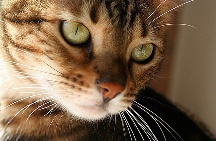

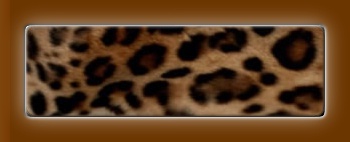

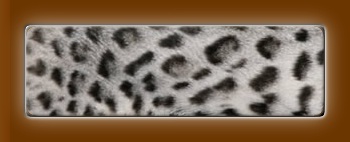


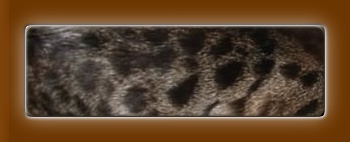
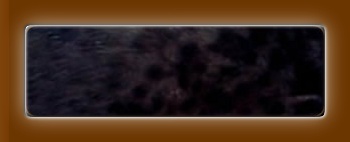
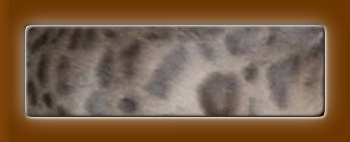
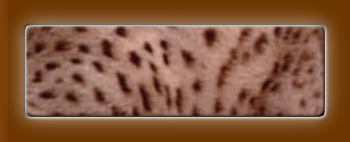
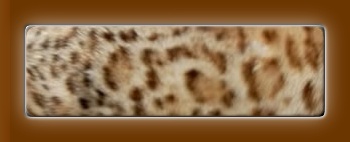
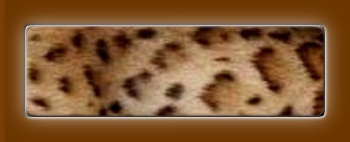
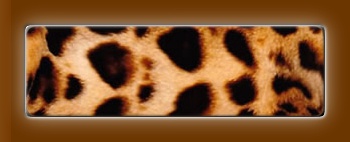
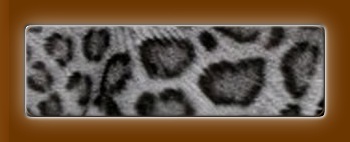

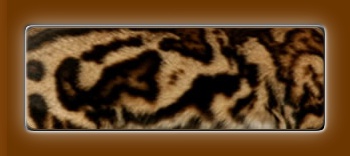
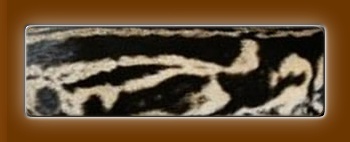

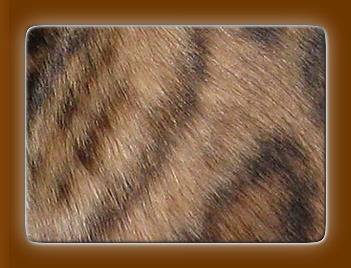


Brown
This colour has a large range of background colours with descriptive terms such as golden, cream, tawny, honey, taupe, buff, tan, beige, caramel or red.
The brown Bengal will have black or deep brown spotted or marble pattern. Their eye colours are green or golden.
Silver
This colour has a background of almost white, silvery or silver in colour with inky black spotted or marble pattern.
Their eye colour is green or golden.
Snow
This term refers to a group of colours with three distinctive genetic variations being the Seal Lynx Point, the Seal Mink and the Seal Sepia.
Seal lynx point (genetically a "cs, cs" Snow)
The SLP is the lightest of the snow group in colour and most often is born white or with very faint markings.
Their pattern usually comes in later and most often starting at the points. The SLP will have a brownish-grey, tan or buff spotted or marble pattern on a white or cream background.
The one very unique thing about the SLP is that they are the only Bengal colour with the clear ice blue eye colour.
Seal Mink (genetically a "cb, cs" Snow)
The SM will usually be born with a detectable pattern that will usually darken some as they grown.
The colour background of the SM is usually in ivory, cream or buff with an almost caramel-chocolate tone to their spotted or marbled pattern. Sm's have aqua or green eyes.
Seal Sepia (genetically a "cb, cb" Snow)
Are usually the darkest of the snow group and are most often born with a distinctive pattern in seal brown to dark seal brown spotted or marble pattern.
The SS eye colour is golden or green.
NON-RECOGNISED COLORS
Besides the recognized colours listed above the Bengal Cat can produce other rare colours that have been brought down through the generations with recessive genes that can show up from time to time.
Charcoal
This colour while believed by some to be a separate genetic colour is also used by many as a descriptive term for the darkest range on the spectrum within the recognized colours.
i.e. Charcoal Brown and Charcoal Silver. "Charcoals" have very little to no rufusing in their wild dark greyish and/or dark brownish background colour. They will have very dark (if not black) spots or marble pattern.
Charcoals have dark masks and in the spotted pattern you can notice a thick back stripe running the length of their body along the back, also known as a "cape". Breeders are also now noting the charcoal colour variation in Snows and are referring to them as "Charcoal Snows".
In the above photo album is a picture of a hybrid Jaglion that has the same dramatic feel as the charcoal Bengal.
Melanistic (Black)
This is a colour that has a black background with faint dark brown-black spotted pattern which can sometimes only be seen in natural sunlight.
Blue
This colour tends to have a buttery-peachy toned background colour with bluish-gray spotted or marbled pattern. The Blue Bengal's pattern and markings will never turn black.
This dilute colour is not found in the wild cat species and therefore currently not considered for inclusion in the breed.
BENGAL SPOTTED PATTERNS
There are only two patterns under which Bengals Cats are shown (Spotted or Marble) there are descriptive terms used to define the types of pattern seen.
Within the spotted pattern you will hear many descriptive terms referring to the type of spotted pattern a cat or kitten might have.
The most common terms are; Single-Spotting, Cluster Rosettes, Paw-Print Rosettes, Doughnut Rosettes, Arrowhead (Rosettes), Embryonic Rosettes.
All of these styles are classed for showing under "spotted".
The rosette colour pattern is a desirable marking for Bengals Cats and has more than one shade of color in the pattern. At first glance a rosette pattern can look like a spot that fades in color towards the middle of the spot. But this is not the case. Most rosetted cats will in fact display a range of styles within the one coat pattern. it is not required that the cats pattern be solely one design of rosettes, and in fact the combination of designs lends towards that random unique look of the Bengal.
A rosette pattern has a distinct alternate colour different from the background colour that is then "outlined or edged" by a darker or different distinctive colour.
Here are some examples of different styles of the spotted pattern.
Single-Spotting
Is used to define a pattern that has no second colour to the spot (there is only the background colour of the cat and the one spot colour).
Cluster Rosettes
Is used to define a pattern with small spots forming clusters around the second “inner” colour that is different from the background.
Paw-Print Rosettes
Is used when the rosette is open on one side and there are spots edging the second colour creating a pattern that looks like paw prints walking across the background.
Embryonic Rosettes
Is when the spot shows subtle signs of a second colour on the edges. (note; this pattern is also displaying the arrowhead pattern as an embryonic rosette)
Doughnut Rosettes
Is used to define a rosette that is completely or almost completely outlined with a darker colour and the center is a distinctly different colour to that of the background.
Arrowhead Rosettes
Is used when you see a spot or rosette in triangular shapes with the “tip of the arrow” pointing toward the back of the body. (note; this pattern can also be solid in the single spotted group.)
BENGAL MARBLED PATTERNS
Within the Marble pattern you will hear descriptive terms referring to the type of marble pattern a cat or kitten might have. You'll find the most common terms below.
Tri-Colour and Quad-Colour
Describes when there are three definite colours present, the background, the marble markings and the center, like seen in a spotted doughnut rosette pattern.
The same for a quad-colour pattern you will see four distinctive colours that make up the pattern and background.
Horizontal Flowing
This is used to describe when you see the marble pattern flowing from the upper shoulder along the body to the back of the cat in a horizontal fashion. This affect is much like the markings on a boa constrictor.
This style of marbling is highly desired in the marble pattern.
GLITTER
The Bengal breed is the original domestic cat displaying "Glitter".
Glitter is a highly desirable trait and not all Bengals have it. You can recognize glitter, by the sparkling effect of the cats coat. Even in low lighting you can see the sheen of the glitter on the front paws and legs of a glittered Bengal. "Glitter" is a translucent hollow hair shaft that catches light and reflects it, that is present throughout the pelt.
The best way to visualize the glitter effect is it to think of it as a sprinkling of gold, silver or crystal fairy dust over the coat that shimmers when the cat moves in certain lights. Having Glitter in a pelt is amazingly eye catching.
While glitter is not required in the Bengal breed it is highly prized and enhances their exotic quality as a unique breed.
WHITE TUMMIES
The Asian Leopard Cats among many other wild cat species have a 'white tummy'. This trait adds to the wild beauty of the Bengal breed.
Quality breeders of Bengals strive to produce cats that reflect wild colour and pattern traits. The Bengal breed should have lighter colored tummies (the lighter the better) in comparison with the background colour.
Bengals are also required to have spotted tummies. Dedicated breeders are striving to duplicate the white belly, inside of legs, throat, and neck of the wild Asian Leopard Cat, while, at the same time, keep the beautiful and vibrant body color of the Bengal.
The success of producing whited tummies is still rare. When breeders are successful in producing this in their cats and kittens it is considered highly prized.
The result of having the spotted whited tummy gives the Bengal breed a very unique wild look closely reflecting their wild ancestors the Asian Leopard Cat.
This colour has a large range of background colours with descriptive terms such as golden, cream, tawny, honey, taupe, buff, tan, beige, caramel or red.
The brown Bengal will have black or deep brown spotted or marble pattern. Their eye colours are green or golden.
Silver
This colour has a background of almost white, silvery or silver in colour with inky black spotted or marble pattern.
Their eye colour is green or golden.
Snow
This term refers to a group of colours with three distinctive genetic variations being the Seal Lynx Point, the Seal Mink and the Seal Sepia.
Seal lynx point (genetically a "cs, cs" Snow)
The SLP is the lightest of the snow group in colour and most often is born white or with very faint markings.
Their pattern usually comes in later and most often starting at the points. The SLP will have a brownish-grey, tan or buff spotted or marble pattern on a white or cream background.
The one very unique thing about the SLP is that they are the only Bengal colour with the clear ice blue eye colour.
Seal Mink (genetically a "cb, cs" Snow)
The SM will usually be born with a detectable pattern that will usually darken some as they grown.
The colour background of the SM is usually in ivory, cream or buff with an almost caramel-chocolate tone to their spotted or marbled pattern. Sm's have aqua or green eyes.
Seal Sepia (genetically a "cb, cb" Snow)
Are usually the darkest of the snow group and are most often born with a distinctive pattern in seal brown to dark seal brown spotted or marble pattern.
The SS eye colour is golden or green.
NON-RECOGNISED COLORS
Besides the recognized colours listed above the Bengal Cat can produce other rare colours that have been brought down through the generations with recessive genes that can show up from time to time.
Charcoal
This colour while believed by some to be a separate genetic colour is also used by many as a descriptive term for the darkest range on the spectrum within the recognized colours.
i.e. Charcoal Brown and Charcoal Silver. "Charcoals" have very little to no rufusing in their wild dark greyish and/or dark brownish background colour. They will have very dark (if not black) spots or marble pattern.
Charcoals have dark masks and in the spotted pattern you can notice a thick back stripe running the length of their body along the back, also known as a "cape". Breeders are also now noting the charcoal colour variation in Snows and are referring to them as "Charcoal Snows".
In the above photo album is a picture of a hybrid Jaglion that has the same dramatic feel as the charcoal Bengal.
Melanistic (Black)
This is a colour that has a black background with faint dark brown-black spotted pattern which can sometimes only be seen in natural sunlight.
Blue
This colour tends to have a buttery-peachy toned background colour with bluish-gray spotted or marbled pattern. The Blue Bengal's pattern and markings will never turn black.
This dilute colour is not found in the wild cat species and therefore currently not considered for inclusion in the breed.
BENGAL SPOTTED PATTERNS
There are only two patterns under which Bengals Cats are shown (Spotted or Marble) there are descriptive terms used to define the types of pattern seen.
Within the spotted pattern you will hear many descriptive terms referring to the type of spotted pattern a cat or kitten might have.
The most common terms are; Single-Spotting, Cluster Rosettes, Paw-Print Rosettes, Doughnut Rosettes, Arrowhead (Rosettes), Embryonic Rosettes.
All of these styles are classed for showing under "spotted".
The rosette colour pattern is a desirable marking for Bengals Cats and has more than one shade of color in the pattern. At first glance a rosette pattern can look like a spot that fades in color towards the middle of the spot. But this is not the case. Most rosetted cats will in fact display a range of styles within the one coat pattern. it is not required that the cats pattern be solely one design of rosettes, and in fact the combination of designs lends towards that random unique look of the Bengal.
A rosette pattern has a distinct alternate colour different from the background colour that is then "outlined or edged" by a darker or different distinctive colour.
Here are some examples of different styles of the spotted pattern.
Single-Spotting
Is used to define a pattern that has no second colour to the spot (there is only the background colour of the cat and the one spot colour).
Cluster Rosettes
Is used to define a pattern with small spots forming clusters around the second “inner” colour that is different from the background.
Paw-Print Rosettes
Is used when the rosette is open on one side and there are spots edging the second colour creating a pattern that looks like paw prints walking across the background.
Embryonic Rosettes
Is when the spot shows subtle signs of a second colour on the edges. (note; this pattern is also displaying the arrowhead pattern as an embryonic rosette)
Doughnut Rosettes
Is used to define a rosette that is completely or almost completely outlined with a darker colour and the center is a distinctly different colour to that of the background.
Arrowhead Rosettes
Is used when you see a spot or rosette in triangular shapes with the “tip of the arrow” pointing toward the back of the body. (note; this pattern can also be solid in the single spotted group.)
BENGAL MARBLED PATTERNS
Within the Marble pattern you will hear descriptive terms referring to the type of marble pattern a cat or kitten might have. You'll find the most common terms below.
Tri-Colour and Quad-Colour
Describes when there are three definite colours present, the background, the marble markings and the center, like seen in a spotted doughnut rosette pattern.
The same for a quad-colour pattern you will see four distinctive colours that make up the pattern and background.
Horizontal Flowing
This is used to describe when you see the marble pattern flowing from the upper shoulder along the body to the back of the cat in a horizontal fashion. This affect is much like the markings on a boa constrictor.
This style of marbling is highly desired in the marble pattern.
GLITTER
The Bengal breed is the original domestic cat displaying "Glitter".
Glitter is a highly desirable trait and not all Bengals have it. You can recognize glitter, by the sparkling effect of the cats coat. Even in low lighting you can see the sheen of the glitter on the front paws and legs of a glittered Bengal. "Glitter" is a translucent hollow hair shaft that catches light and reflects it, that is present throughout the pelt.
The best way to visualize the glitter effect is it to think of it as a sprinkling of gold, silver or crystal fairy dust over the coat that shimmers when the cat moves in certain lights. Having Glitter in a pelt is amazingly eye catching.
While glitter is not required in the Bengal breed it is highly prized and enhances their exotic quality as a unique breed.
WHITE TUMMIES
The Asian Leopard Cats among many other wild cat species have a 'white tummy'. This trait adds to the wild beauty of the Bengal breed.
Quality breeders of Bengals strive to produce cats that reflect wild colour and pattern traits. The Bengal breed should have lighter colored tummies (the lighter the better) in comparison with the background colour.
Bengals are also required to have spotted tummies. Dedicated breeders are striving to duplicate the white belly, inside of legs, throat, and neck of the wild Asian Leopard Cat, while, at the same time, keep the beautiful and vibrant body color of the Bengal.
The success of producing whited tummies is still rare. When breeders are successful in producing this in their cats and kittens it is considered highly prized.
The result of having the spotted whited tummy gives the Bengal breed a very unique wild look closely reflecting their wild ancestors the Asian Leopard Cat.

Colour types and patterns




About Bengal Cats
The Origin of Bengals
Bengals are descendants of the Asian Leopard cat crossed with a domestic cat. So yes they are bred from a true wild cat, however a Bengal is not wild by nature like you would assume it to be.
The first child of a domesticated cat and an Asian Leopard cat is considered an F1 cat.
A Bengal is not a Bengal until that child is bread with a domestic cat, then that child is bred with a domestic cat and then that child is bred with a domestic cat to create what is considered and F4 –
This is the Bengal cat that is accepted within Cat Shows and is typically the one you will get as your pet. You may even get an F5 or an F6.
What’s wonderful about Bengals is that since they originate from a crossing of a wild cat and a domestic cat breeders, from the start in the 1960's, have ensured that the domestic cat has only the best traits when it comes to personality, health and looks through each generation of breeding.
This has ensured that Bengals are well tempered and only the best traits have come through.
Physical Traits
Because of their Asian Leopard heritage they do have some traits that are different from regular cats. In addition to the list of traits below one impressive feature is that they are immune to FLV (Feline Leukemia).
Their Coat:
Is beautifully spotted or marbled and come in some different ranges of colour but silver/ brown is most common but also come in white (snow Bengal), grey, reddish brown, pink (mink seal), black (panther like) and a variety of brown/orange that have almost a tiger like colour quality
Is not thick like a normal domesticated cats and is instead super soft and very much like a Rabbit’s fur and is pelt like in quality.
Their bellies are not white but spotted Glittering fur – Because of the pelt like state of their fur most Bengals have a gold glitter effect in their fur that seems to shimmer when they are in the sun.
Their Head:
Has a mascara colouring around the eyes
The eyes are much more reflective than a normal domestic house cat (I haven’t found much documentation on this, however when taking photos of both my tabbies and my Bengal at the same time I’ve noticed her eyes glow far more than my other domestic cat
They have rounded ears compared to a domestic cats pointy ears
Has intense facial markings and usually darker colour of fur around the nose
Their build:
They have a longer body than a domesticated cat
Muscular hind legs with the ability to run very quickly
They can jump higher than most breeds with a few exceptions
They have a longer tail
Manual Dexterity in their front paws – This something I haven’t read but seen for myself in Cookie.
Overall Bengals cats take up to 2 years to mature and reach adult size and weight, inherited from the Asian Leopard Cat
Their Voice:
They have a huge vocal range, more so than a domestic cat
They can meow but they also chirrup, chrip, grumble, chatter and several other noises you won’t understand till you have heard it
Personality Traits
Where do you start when you have a laundry list of amazing personality traits ?
Bengal cats are extremely active and playful cats, remaining kittenesque for pretty much all their life. Tie into this that they are very curious and highly intelligent they sometimes can get into things they shouldn’t. They are also quite dog-like and usually come when you call them, fetch their toys when they want to play and can be trained to do tricks. What this all boils down to is a cat who is very curious about any new objects or things in the home. They aren’t scared of new people and prefer to investigate them. They always want to play and they love to climb and be up high (Taboo always jumps onto my shoulder).
This active side mixed with the Asian Leopard influences make them love some things normal cats don’t love.
1. Water – Bengals are known to love water and will play in a tub of water or with running water from the sink.
2. Food – Bengals eat a wide range of food, pretty much anything, from what I’ve experienced they love raw chicken wings
I’ve read that Bengals typically bond with one person in the family more so than others and I have found this not true in our house, they spend time with everyone in our household and comes to anyone who calls them or happens to be in the kitchen and proceeds to beg for treats. Bengals aren’t overly cuddly cats, however mine dont mind being held and have their moments where they just want to sit on my lap.
Each Bengal, like each domestic cat will be unique and is also directly affected by it’s upbringing, but these are some of the common traits you can expect.
Bengals are descendants of the Asian Leopard cat crossed with a domestic cat. So yes they are bred from a true wild cat, however a Bengal is not wild by nature like you would assume it to be.
The first child of a domesticated cat and an Asian Leopard cat is considered an F1 cat.
A Bengal is not a Bengal until that child is bread with a domestic cat, then that child is bred with a domestic cat and then that child is bred with a domestic cat to create what is considered and F4 –
This is the Bengal cat that is accepted within Cat Shows and is typically the one you will get as your pet. You may even get an F5 or an F6.
What’s wonderful about Bengals is that since they originate from a crossing of a wild cat and a domestic cat breeders, from the start in the 1960's, have ensured that the domestic cat has only the best traits when it comes to personality, health and looks through each generation of breeding.
This has ensured that Bengals are well tempered and only the best traits have come through.
Physical Traits
Because of their Asian Leopard heritage they do have some traits that are different from regular cats. In addition to the list of traits below one impressive feature is that they are immune to FLV (Feline Leukemia).
Their Coat:
Is beautifully spotted or marbled and come in some different ranges of colour but silver/ brown is most common but also come in white (snow Bengal), grey, reddish brown, pink (mink seal), black (panther like) and a variety of brown/orange that have almost a tiger like colour quality
Is not thick like a normal domesticated cats and is instead super soft and very much like a Rabbit’s fur and is pelt like in quality.
Their bellies are not white but spotted Glittering fur – Because of the pelt like state of their fur most Bengals have a gold glitter effect in their fur that seems to shimmer when they are in the sun.
Their Head:
Has a mascara colouring around the eyes
The eyes are much more reflective than a normal domestic house cat (I haven’t found much documentation on this, however when taking photos of both my tabbies and my Bengal at the same time I’ve noticed her eyes glow far more than my other domestic cat
They have rounded ears compared to a domestic cats pointy ears
Has intense facial markings and usually darker colour of fur around the nose
Their build:
They have a longer body than a domesticated cat
Muscular hind legs with the ability to run very quickly
They can jump higher than most breeds with a few exceptions
They have a longer tail
Manual Dexterity in their front paws – This something I haven’t read but seen for myself in Cookie.
Overall Bengals cats take up to 2 years to mature and reach adult size and weight, inherited from the Asian Leopard Cat
Their Voice:
They have a huge vocal range, more so than a domestic cat
They can meow but they also chirrup, chrip, grumble, chatter and several other noises you won’t understand till you have heard it
Personality Traits
Where do you start when you have a laundry list of amazing personality traits ?
Bengal cats are extremely active and playful cats, remaining kittenesque for pretty much all their life. Tie into this that they are very curious and highly intelligent they sometimes can get into things they shouldn’t. They are also quite dog-like and usually come when you call them, fetch their toys when they want to play and can be trained to do tricks. What this all boils down to is a cat who is very curious about any new objects or things in the home. They aren’t scared of new people and prefer to investigate them. They always want to play and they love to climb and be up high (Taboo always jumps onto my shoulder).
This active side mixed with the Asian Leopard influences make them love some things normal cats don’t love.
1. Water – Bengals are known to love water and will play in a tub of water or with running water from the sink.
2. Food – Bengals eat a wide range of food, pretty much anything, from what I’ve experienced they love raw chicken wings
I’ve read that Bengals typically bond with one person in the family more so than others and I have found this not true in our house, they spend time with everyone in our household and comes to anyone who calls them or happens to be in the kitchen and proceeds to beg for treats. Bengals aren’t overly cuddly cats, however mine dont mind being held and have their moments where they just want to sit on my lap.
Each Bengal, like each domestic cat will be unique and is also directly affected by it’s upbringing, but these are some of the common traits you can expect.










